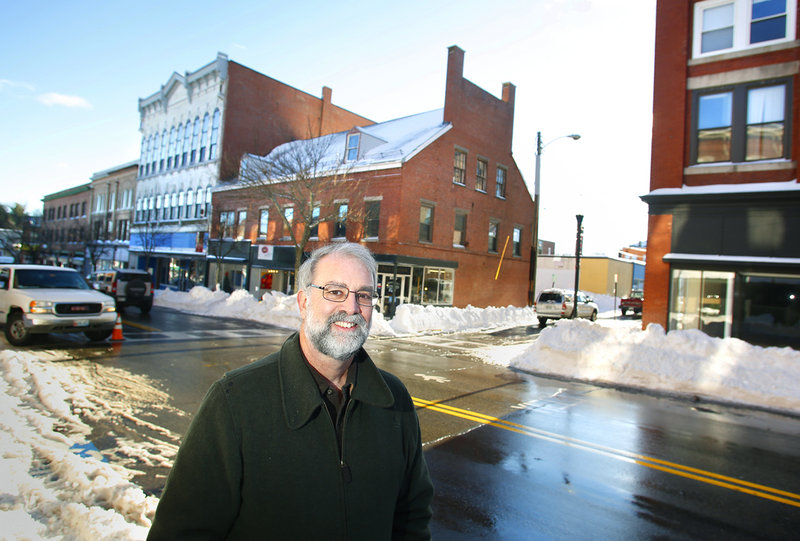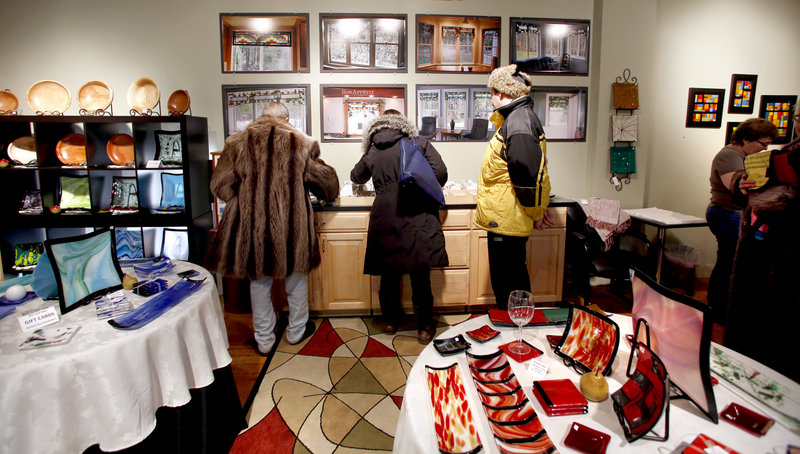BIDDEFORD – From his office at City Hall, Mayor Alan Casavant has a clear view of the “big blue obstacle” he feels has long stood in the way of economic development.
There, in the heart of the downtown mill district, sits Maine Energy Recovery Co., the trash incinerator that for nearly three decades has generated complaints about odor, pollution and truck traffic. The facility will close this week, ushering in what downtown leaders hope is a new era of economic development and vibrancy for an old mill town once dubbed “Trashtown USA.”
Casavant sees the departure of MERC as a pivotal moment for a city that has been dominated by a trash incinerator — and the stigma that came with it — for the past 25 years.
“It’s so critical we exorcise our demon and move forward,” he said. “This is a turning point for the city.”
In late November, the city closed on the $6.65 million purchase of the MERC property from its Vermont-based parent company, Casella Waste Systems, which had decided to close the plant and shift operations to a new location in Westbrook. Casella will dismantle the plant and clean up the riverfront property, leaving in place only the smokestack, which holds revenue-producing cellphone towers. The city will pay for the purchase largely through that revenue and tax increment financing funds designated for downtown development.
By buying the MERC property, the city is demonstrating its commitment to economic development, Casavant said. At the same time, he said, the city is rewriting its story line.
“We’re changing the paradigm, we’re changing the stereotype and we’re moving forward,” he said. “Most people, I believe, are firmly behind the purchase because they understand it will change Biddeford’s landscape.”
But how much change and how quickly it will happen remain to be seen.
City officials and developers say they have seen an increase in the number of businesses and people interested in investing in Biddeford, including on the MERC site. At last three new businesses have opened downtown in the past month and new companies continue to move into the sprawling Pepperell Mill Campus, which has grown to include 80 residential units and 82 businesses. Other mill buildings house a mix of manufacturing and residential uses.
Daniel Stevenson, the city’s economic development director, said he began receiving calls about the 8.5-acre MERC site as soon as the city announced it would buy the facility. The riverfront property is in the mill district and about a block off Main Street, a location he sees as ripe with development potential. The City Council ultimately will decide what it wants to do with the property. The council also will vote on a proposal to build a $10.1 million, 505-space parking garage downtown, an infrastructure improvement Stevenson and mill developer Doug Sanford say is essential to attracting more businesses to downtown and the mill district.
“The hustle and bustle you hear a lot of residents talk about seeing in the past, we’ll have a resurgence of that,” Stevenson said. “It will take time, but right now the groundwork is absolutely being laid for that.”
Much of Biddeford’s history is tied to downtown, where large brick mills built on the banks of the Saco River churned out textiles that were shipped around the globe. Generations of Biddeford families — many of French Canadian descent — made a living in the mills until the last textile manufacturer shut its doors in 2009, bringing that 150-year tradition to an end.
When WestPoint Home closed its blanket manufacturing operation in 2009, George “Pete” Lamontagne lost the job he held since returning to Biddeford after serving overseas in the military in the 1960s. A former city councilor who grew up downtown, he has watched closely the evolution of his hometown. Sitting at a coffee shop in the lobby of the North Dam Mill recently, he reflected on the changes he has seen.
In the 1950s, Lamontagne said, downtown was bustling with mill employees heading to work and people shopping in the department stores that anchored Main Street.
“You could get anything you wanted on Main Street,” Lamontagne said. “It was a fine shopping community.”
By the time he returned to town in 1965, Lamontagne saw things were starting to slow down on Main Street as larger department stores opened near Portland and the number of people working in the mills slowly decreased. The decline in downtown activity continued into the 1970s, when a horseshoe pit was set up on the stage of the once-vibrant City Theater. Then, in the early 1980s, Biddeford began courting MERC, competing with Saco for rights to locate the trash incinerator in the city.
MERC opened in 1987 in a downtown Lamontagne said many people had already given up on.
“That pretty much did Biddeford in,” he said.
Casavant sat on the City Council that decided to bring MERC to the city. At the time, he said, burning trash was seen as a better option than a landfill. The city would benefit from more tax revenue and an arrangement to dispose of trash at a state-of-the-art facility. Plus, the downtown was in decline and there was a negative stigma attached to the mills, he said.
“It was viewed as an old industry and an old way of doing business. It captured so many people for so long. Today when we look at these mills we see them as agents of change. In the 1980s, they were weighted down with the baggage of the past,” he said. “The idea of an incinerator going into space once housed by old mill buildings seemed like good economic development.”
The departure of MERC isn’t the only activity contributing to the downtown revitalization, Casavant said. He credits much of the change in attitude to people who have moved to and invested in Biddeford in the past decade. It was their enthusiasm that prompted him to run for mayor.
“People are coming here from away and bringing with them different expectations and different views of the city,” Casavant said. “The people who moved here saw the glass as half full, they saw things that were not obvious to the people who lived here. They brought new vitality.”
Lamontagne, recently named the downtown supporter of the year by the nonprofit Heart of Biddeford, believes the new energy downtown is “the only thing keeping it going.” There are new artist studios, a monthly art walk, a variety of ethnic restaurants.
“If it wasn’t for that, there would be nothing downtown,” he said.
Tammy Ackerman, a downtown resident who runs Engine, a nonprofit that promotes arts and culture in the city, isn’t surprised much of the energy in downtown Biddeford is centered on the arts. Urban renaissances are often led by artists who move into affordable areas and “make it cool,” creating excitement and vitality downtown, she said.
“Whenever I’m out talking to people, specifically around the arts, they’ll say ‘I hear Biddeford is doing great things,”‘ she said. “Changing the perception (of Biddeford) is the key. There’s a lot of attention focused on us right now. I think people are excited about a new era.”
That excitement extends beyond people discovering Biddeford for the first time to residents who haven’t been downtown in years, Ackerman said.
“It’s nice when you get some of the old-timers who come down for events and they’re excited,” she said. “They remember Main Street packed with people on Friday and Saturday nights. It’s never going to be exactly like that again, but it can certainly have some of those qualities.”
Sanford, the owner of the Pepperell Mill Campus and other downtown properties, sees attitudes toward Biddeford shifting as people rediscover their pride in the city. Biddeford residents also are now seeing the mills as “great infrastructure that will allow us to attract more job creation.”
“Other communities, the Portlands and Portsmouths of the world, would love to have this kind of infrastructure that can be developed for the 21st century,” he said.
Lamontagne, the former city councilor, is encouraged by the renewed interest and investment in the city he loves. Biddeford, he said, “is well on its way.”
“Biddeford is done going backward,” he said. “It’s moving forward.”
Staff Writer Gillian Graham can be contacted at 791-6315 or at:
ggraham@mainetoday.com
Send questions/comments to the editors.









Comments are no longer available on this story